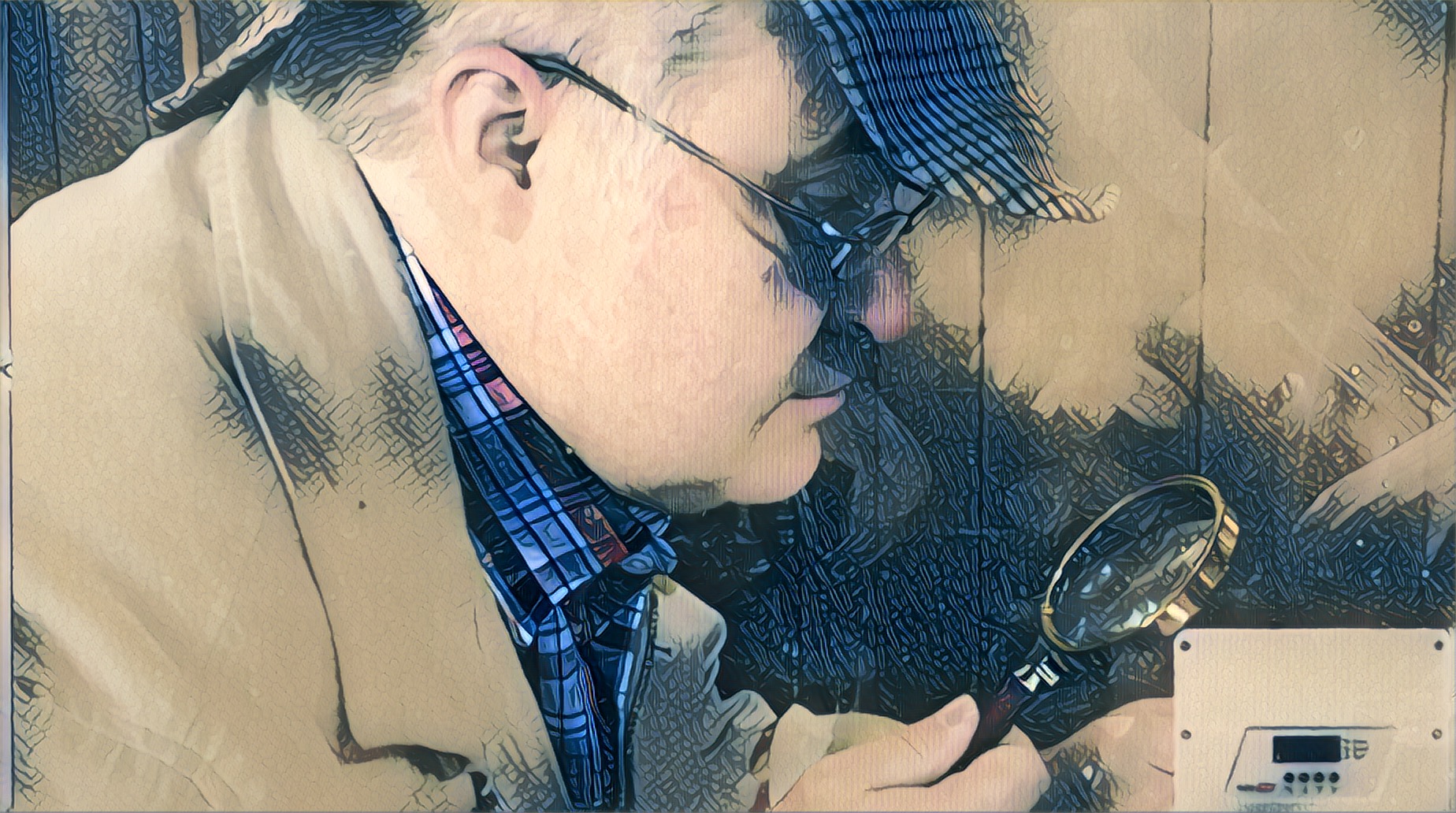
Today Ronald examines the SolarEdge HD Wave inverter. It’s small. But not that small.
It’s An Itsy Bitsy, Teeny Weeny, SolarEdge, HD Wave String Inverter…
SolarEdge, an Israeli company, has produced the HD Wave — the world’s smallest string inverter. By size, this little cracker takes more DC than any inverter out there. Not only that, but it grabs DC, uses its funky HD wave technology on it, and spurts out the AC our homes use with greater efficiency than any thing else on the market. And it’s now available in Australia, starting from a couple of weeks ago.
In fact, if you really want the low down on this inverter, you can’t go past this review Mark Cavanagh at MC Electrical wrote. He scored himself one of the few HD Wave inverters in Australia, pulled its cover off and checked out its guts, made it fight a Fronius inverter to see who would win1, and even took pictures of it with his special ghost detecting infrared camera — presumably to make sure the spirits of our ancestors aren’t bound to spend eternity transforming electricity on the AC/DC High Way To Hell.
Also, SolarQuotes own Michael Bloch recently wrote about how a combined HD wave inverter/charger will shove its DC right into your car. Provided of course, your car is electric. EVs2 are all about the DC.
With all this great material about the HD Wave already on the internet, you may be wondering why I am bothering to write about it. Well, I am uniquely qualified to address certain aspects of the HD Wave that others have not yet touched upon. For example, how cute it is.
Sure, I’m not talking about a Japanese child wearing a koala shirt, with koala hair clips, wearing a koala backpack, and holding an actual koala levels of cuteness, but I think its small size means it has to take second place behind the Hello Kitty solar inverter. (While I’ve never actually seen a Hello Kitty inverter, I assume there is one, because there is a Hello Kitty everything.)
And since I have started writing about it, I may as well give you all the information I have.
HD Wave Inverter Is A Great Name — Pity It’s Not Called That
The inverter uses funky new HD wave technology to decrease its size and increase its efficiency, so you’d probably think HD Wave would be a great name for it. But that’s not what it’s called at all. All SolarEdge did was take the old name of their inverter and stick a H in it. The new HD wave version of its old 5 kilowatt SE5000A inverter is now simply SE5000H. That’s a very humble approach to take.
Thank god I’m not humble. I’m calling it HD Wave all the way, baby!
HD Wave Technical Specs
Here is a somewhat boring table from the HD Wave’s datasheet I smooshed together a little so people using smartphones will have a chance of being able to read it:
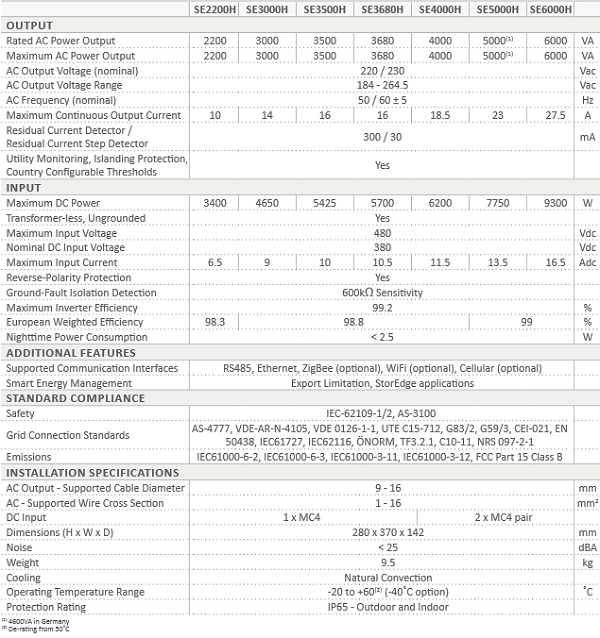
HD Wave technical details from its datasheet
It’s Fun Size — But Not Quite That Much Fun
If the combined resolution of your eyeballs and screen are high enough, you may be able to make out the dimensions of the HD Wave above. They are 280 x 370 x 142 mm. Or for those of us who aren’t quite so precise, that’s 28 x 37 x 14 cm, which is around the height and width of a microwave oven and a little less than half the depth.
Except this isn’t really true.
Rather than looking like this:
It has a bloody big DC isolator switch stuck on its arse that will increase its size by one-third:
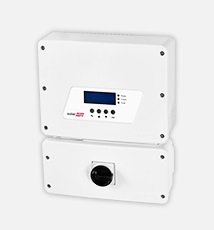
“Tell me the truth. Does this DC isolator switch make my bottom look big?”
So while it is small, it’s not quite as small as some pictures suggest. Without including DC isolator switches it is around half the size of more conventional inverters of similar capacity and just a little more than half the weight.
SolarEdge Inverters Are Made For Use With Optimizers
Like all SolarEdge inverters, the HD Wave is made for use with DC optimizers. These are electronic devices that are attached beneath solar panels and optimize their output so each one will always perform at its overall best without affecting the output of other panels. This gives several advantages which include increased output, particularly for systems that suffer from shade, and the ability to monitor individual panels. It also allows panels to be shut down in case of a fault as a safety feature.
The disadvantage of optimizers is they need to be paid for and, unless smart panels that have them built in are used, the labour involved in attaching them to panels increases the cost of installation. It will be interesting to see if SolarEdge moves away from using optimizers to using panels with Maximum Integrated style panel string optimization, now they are so competitively priced3.
HD Wave Technology
Here is a diagram of the HD Wave with its cover off, brazenly displaying its electronics to the world:
One reason it is so much smaller than other inverters is because it uses thin-film capacitors instead of larger electrolytic ones. Besides being less bulky, SolarEdge says the thin-film ones are more reliable. This is not an unreasonable claim and I certainly hope they are correct, but we’ll have to wait and see.
SolarEdge also says it has 16 times less magnetics. Inverters take non-wavy DC power and turn it into wavy AC power. To get the waves right, inverters use magnetics, which are big copper coils, to smooth it out. The HD Wave gets away with less because its electronics are able to make a pretty good wave to begin with, and not a crappy one, as they seem to suggest everyone else is doing in the diagram below:
Its Efficiency Is The Best
The SolarEdge HD Wave has the highest efficiency of any inverter available. It’s datasheet says its European weighted efficiency is 98.3% for the smallest 2.2 kilowatt one, 98.8% for the 3 to 4 kilowatt ones, and 99% for those that are 5 and 6 kilowatts. In comparison with two other top of the line inverters, the same figure for the 5 kilowatt SMA Sunny Boy 5000TL is 96.5% and the 4.6 kilowatt Fronius Primo 4.6-1 is 96.3%.
It’s high efficiency means that, all else equal, it will produce roughly 2-3% more electricity than most other new inverters. This is clearly an advantage for those who want to get the most out of their system. But note that maxing out your solar panel capacity in relation to your inverter capacity, so it is as close to being one-third larger than the inverter’s capacity as possible, is usually the most cost effective step for increasing a system’s overall energy production.
High Efficiency Means Less Heat
The higher an inverter’s efficiency the less waste heat it produces and the HD Wave produces less than one-third as much heat per kilowatt-hour of AC electricity output than the competition. All else equal, this means the HD Wave should operate at a lower temperature than other inverters.
But all else is not equal.
Only counting the actual inverter and not the DC isolator switch stuck at the bottom, the HD Wave is roughly half the size of comparable inverters, which means the heat it does produce is packed inside half the space. Also, unlike some inverters, it doesn’t have fans to provide active cooling. So while I expect it to run a little cooler than other inverters, I don’t expect too much of a difference.
It Has A 12 Year Warranty
SolarEdge inverters have a 12 year warranty, which is the longest of any in Australia I am aware of. But it is a limited warranty and if SolarEdge decides to replace an inverter they will only provide the replacement and won’t cover the cost of installation:

A chunk of the SolarEdge inverter warranty.
In my personal opinion, neither the customer or installer should be out of pocket if a new SolarEdge inverter fails, and while I am no lawyer, I believe Australian consumer law agrees with me. Australians can seek compensation for consequential losses resulting from a problem with a product and this includes the cost of installation for a replacement. If you have a problem with being compensated by SolarEdge, this page says what you can do. Consumer organizations in your state should also be able to assist.
Fortunately, provided you chose a professional installer, they should handle any inverter problems you have during its warranty period, free of charge. They are not permitted to just fob you off onto SolarEdge and make you sort it out with them. Other good news is you should be unlikely to need to use their warranty. But the HD Wave is new technology and there is always the risk it won’t be as reliable as expected.
SolarEdge’s DC optimizers, which are fitted to each solar panel, are warranted for 25 years.
The Wave Of The Future
The SolarEdge HD Wave is an impressive piece of technology and sets the standard for other inverters to meet. I suspect many manufacturers will begin to use HD Wave technology in the future. Unfortunately, it doesn’t have a full replacement warranty, but hopefully SolarEdge will fix that. With record breaking efficiency and panel level DC optimization and monitoring, it will appeal to anyone looking for a high end inverter solution.
But, on the down side, it’s bulky DC isolator switch means it’s not quite as cute as it could be.
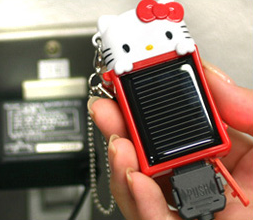
The Hello Kitty Solar Charger. Never leave home without it.

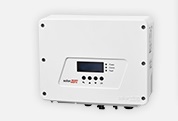
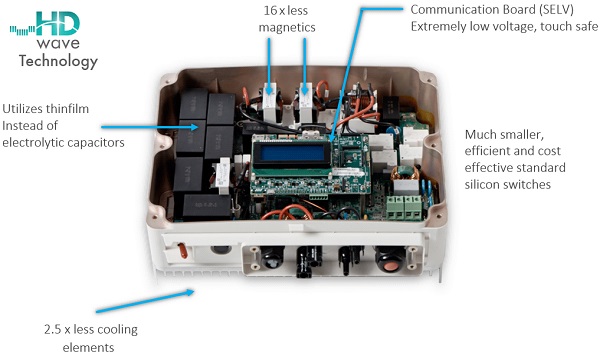
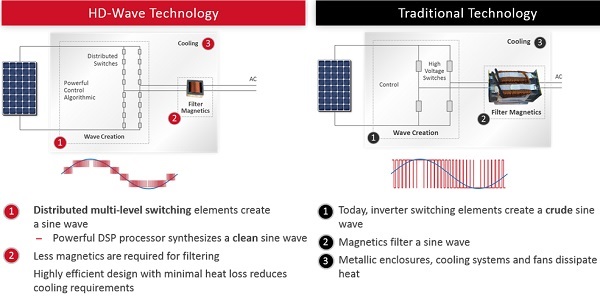
 RSS - Posts
RSS - Posts



“Well, I am uniquely qualified to address certain aspects of the HD Wave that others have not yet touched upon. For example, how cute it is.”
Cuteness really should be an industry wide standardized data point on manufacturer spec sheets so consumers can accurately compare products. Something like a Hello Kitty 5 star rating.
Thanks for the detailed post, but also thanks for the laugh Ronald.
Thanks Ronald for another great article. I too have read Mark Cavanagh’s review and would highly recommend it to readers here also.
Whilst Solar Edge is to be commended for their continued product research and improvement, their focus has unfortunately been mostly towards single phase products, leaving us 3-phase wanks out in the cold unfortunately. The lack of higher spec’ed 3-phase devices has been a real bug bear I would have to say.
In regards to Solar Edge’s EV charging add on, well it is a great idea but I think these will probably have limited appeal because it will restrict the flexibility of installation. I think eMotorWerks solar diversion solution with their Juice Box products, might be a better all round solution for most people … though this is not delivered at DC levels. In any case, given how the Solar Edge device integrates to the HD Wave, it begs a serious question as to how it will interface to an Australian regulated implementation where (and as Ronald rightly points out) it will have a big arse DC isolation switch to contend with. Perhaps that’s why its introduction on the Aussie market has been delay (??).
Anyway, thanks again Ronald for your always light-hearted reviews … LOL
Hi, I have been given a quote for this device in last two weeks.
12 REC panels of 325Watts each fitted with DC optimizers plus a 3Kw Solar edge HD wave inverter.
Cost $5250 installed.
My concerns are that they are going almost 33% over on the Panels and also that 8 of the panels are on a Nth facing roof, the other 4 on a West roof. The 3kW inverter though appears to have only 1 DC string input.
What do you think?
Hi Glenn.
Getting the panels close to 133% of the inverter capacity is no problem as long as they don’t go over the limit. There will be no significant loss of power as a result. I wrote about this here:
https://www.solarquotes.com.au/blog/oversizing-solar-arrays/
As your panels have DC optimizers each one will provide the maximum output it can independently of the others and so it is possible to have them facing different directions. I recently looked at the HD Wave installation manual and didn’t see any restrictions on orientation mentioned.
Thanks Ronald,
Does this system seem reasonable at the quoted cost of $5250? Both parts wise and dollar wise.
The quote includes monitoring via (i assume) Solar Edges server system. This worries me as time passes they may not keep up the system for various reasons. I can’t seem to find any mention of Solar Edges local monitoring. ie independant of solar edge.
glenn
SolarEdge inverter and the DC optimisers are not cheap compared to budget brands of inverters without optimizers, so to me that sounds like a good deal for a 3.9 kilowatt system. If you have a limited amount of suitable roof space it will be a good way to get the most out of your panels.
Hi Ronald,
I am about to have a HD Wave installed, and one point you haven’t mentioned is that SolarEdge allow for up to 155% oversizing on the HD Wave. If you use StoreEdge and a DC battery in this config, you are still CEC compliant for STCs as well apparently 🙂
I liked this in particular because I want to have as big an array as possible once I get a fully electric car and I’m already at my 10kW inverter limit with my distributor.
SolarEdge may be fine with 155% oversizing, but as far as I am aware, no one can get the STCs that reduce the price of rooftop solar if their PV is oversized by more than 133%.
OK, interesting. I’ve read it here: https://www.pveasy.com.au/blog/2017/6/solaredge-optimising-solar and the whirlpool forums have also had installers mentioning it.
The theory being that since the battery can store the excess solar that would otherwise be clipped in summer by an oversized array, then the CEC doesn’t mandate the 133% limit.
I’d love to know if this is actually correct or just an assumption by multiple sources.
Hi Mark, I’ve read through the link I can’t see why having the battery would enable people to exceed the 133% limit for panel capacity over inverter capacity. I’m not aware of there being any flexibility on this, as far as STCs are concerned.
My understanding is, unless an installer wants to run the risk of having STCs rejected for an installation, the panel capacity can only be a maximum of one-third greater than the inverter capacity.
Off-grid installations can go over the 133% limit, but they don’t receive STCs for panel capacity that exceeds that amount.
I’m not aware of batteries making an exception to this. But I’d be interesting in hearing about any examples where having batteries did make a difference.
Is it just the excess over 133% which does not attract STCs, or is it it a case of “make it too big and you get nothing”?
As winter yield is given as 1/3 of summer yield on various PV sites, I’d figured that there’s merit in a 200% to 300% array oversizing for an off-grid installation with a big battery. (As the Z-Cell can only take 2.5 kW (44A @ 57v), I’m back to favouring big lead-acid batteries, and charging them at up to 120A, or around 7 kW, in summer, just to have good power input in the depths of winter.) All I need for that is a pair of MPPT60HV solar chargers, two battery banks, and a battery inverter. A pair of hefty schottky diodes, preferably in SiC, will allow the battery inverter to draw from the most charged bank, without any need for switching between them. It’s a simple DC-coupled architecture, which is appealing. (I’m figuring that on any heavy power draw, the solar charger will flick to bulk charge mode, and power flow will be straight from solar to inverter, with the battery serving only to fill cloud shadows.)
By the time the cheaper lead-acid batteries give up the ghost, there may be a more capable new battery technology – at a reasonable price.
My understanding is, for off-grid installations, the 133% limit can be exceeded but STCs won’t be received for the amount above the limit. On-grid installations run the risk of having all STCs refused if they go over the limit and may be required to remove panels to receive any STCs.
Where is this inverter made?
It is made by Flextronics, also known as Flex. I would have to look into where it is made, but Flex does a lot of manufacturing in Mexico.
Well, I looked into it and apparently SolarEdge/Flex were looking at manufacturing in Mexico, but decided against it and capacity at their factory in Israel was instead increased. Components are apparently made in Singapore and possibly many other places.
Thanks Ronald!
Good on the Israelis for getting the inverter jobs. When Powerwall 1.0 came out, the only inverter that worked with it was StorEdge – that too being made in Israel!
Israel also makes computer chips. Ireland is silly enough to have a 12.5% corporate tax rate across the board. While Israel gives Intel a 5% tax rate till 2023, it is 26.5% for all the other firms in Israel.
Quite insane to give the banks and real estate agents a low tax rate – they produce nothing!
Intel will invest $6 billion in Israel and hire 1000 more people.
Ronald, can you clarify.
I have read that the Solaredge HD Wave inverter is not compatible with the StorEdge Interface and not able to connect with an LG Resu 7H battery?
Also, while I’m at it, have you discussed the ability of an electric car’s battery being used IN/OUT as a storage for house loads?
Thanks
Paul
On the SolarEdge HD Wave datasheet it says, “Compatible with the StorEdge Interface for Smart Energy Management StorEdge applications.” But looking at the StorEdge datasheet I see it only says it is compatible with the LG Chem RESU 10H. So you may have to go up a RESU size for that setup to work.
I haven’t written about using electric vehicles for storage or to provide power to the grid. It is pretty straight forward to put surplus solar electricity into an electric car, although just how much can be put in at one time will be limited by the set up. Unfortunately, it can be more difficult to get power out.
In Australia electricity prices can go over $10 a kilowatt-hour during critical peaks so it could definitely be worthwhile, provided the hardware required to do so isn’t too expensive. However, the more battery storage there is available to supply power during critical peaks, the lower prices will be. If enough low cost stationary battery storage becomes available it may never make much economic sense to use car batteries to supply power to the grid, as they will be optimized more for power and weight rather than low cycle cost.
But electric cars will be great for slurping up any surplus renewable electricity that is generated.
HD Wave inverters have a Storedge option but at the moment it only supports AC Coupling to the battery, and I don’t believe it supports backup mode (i.e. ability to continue powering house loads from the battery during a blackout).
The older (non-wave) Storedge inverters support DC coupling and operating in backup mode.
Ronald
My solar installer has advised that there is a delay in supplying my 5 kw 3 phase SE5K solar edge inverter. The supplier has suggested that due to the possible long length of the delay that they will fit two new technology 2.5 HD wave SE2500H inverters as a solution in parralel or i can wait for the 5kw three phase inverterl. I have a couple of concerns.
1. Will i end up with two of the DC switch boxes or one if i have the 2.5’s
2. I have a three phase airconditioner attached to the house. from what i have read the 2.5’s are single phase. Is this an issue?
3. I am committed to the complete install as they have fitted the solar panels already and then advised the inverter was a delay.
Any assistance you could give this frustrated layman consumer would be appreciated.
Hi Craig,
Finn here.
Although 2 single phase inverters on a 3 phase supply is a totally legitimate solution, in my opinion a single 3 phase inverter is a better solution.
A single inverter across three phases results in more stable operation, with less voltage and frequency swings and less tripping off.
In other words your inverter is much less likely to trip off on ‘over voltage’ or ‘out of frequency’ faults, which is becoming more of an issue as more solar is connected to the grid.
Hope That Helps,
Finn
Can I install SE5000H on 3 phase power supply? My installer is insisting on it. Would it cause any issues.
Hello Cp
It is definitely possible to install a single phase inverter with a home that has 3 phase power. There are advantages to using a three phase inverter that are described here:
https://support.solarquotes.com.au/hc/en-us/articles/115001462573-I-have-3-phase-power-Should-I-use-a-3-phase-inverter-or-a-single-phase-inverter-
But, a single inverter can still work well. (It may be worthwhile asking people you know in your area if they have problem with their inverters tripping or having their output reduced due to grid issues to get an idea if a three phase inverter is likely to help.)
For 6.54kw of Sunpower E327 panels what would be the ideal inverter – SE5000H or SE6000H? Looks like the inverter efficiency curve between the two is the same. Also both of the inverters start working at 250w (low light)
https://www.solaredge.com/sites/default/files/application_note_solaredge_inverters_efficiency.pdf
Hi Cp
Well, they will both give you around the same output. You may get about 1% more with the larger inverter but since it would normally cost more you may be better off with the 5 kilowatt inverter.
If you have single phase power, a 5 kilowatt inverter is all you’ll usually be allowed to install.
Hi Ronald,
Where there is shading issues, is it more economical/better to have Solaredge inverter versus Fronius with selective Tigo deployment? Also I am aware that Solaredge’s warranty (25 years) is way longer than Fronius. I don’t know about Tigo’s warranty.
Please advise.
Thanks and Happy Easter
Stephen
Those two solutions should be about equal. Because every panel with the SolarEdge setup will have optimizers I would expect slightly better performance, but for panels that are unshaded the effect is likely to be quite small. Solaredge’s warranty is only for their optimizers. The inverter has a 12 year warranty. Fronius has what they call a 5+5 warranty where they will replace an inverter that fails within 5 years and pay for installation of the new unit, but in the next 5 years they’ll only provide a new inverter and you’ll have to pay for installation yourself. Tigo optimizers should have a warranty of 25 years.
Which is best will depend on how determined you are to get every last watt out of your solar panels and the price. Without knowing more I couldn’t really guess which is cheaper. Even if I did know more, maybe I couldn’t. But they are both good inverters.
Hi Ronald,
I found out that the difference in cost between the 2 solutions (SolarEdge HD Wave versus Fronius without Tigo any deployment) is about $1000, presumably due to additional installation cost for fixing the optimisers onto the panels. As you mention, in a situation with NO shading issues, there is no much difference in the performance for the 2 solutions.
It seems to me then that the question really boils down to whether the benefits of individual panel optimisation, monitoring and shutdown capabilities is worth $1000. Also one has to be mindful of the cost of future individual optimiser replacement because of SolarEdge limited warranty.
If I install Sunpower panels with Fronius, I have a question:-
When I find that the system efficiency has dropped and I suspect that one of the Sunpower panels has failed, how do I get Sunpower to replace the defective panel since I don’t know which panel has failed as there is no individual panel monitoring capability?
Thanks
Stephen
How much individual panel monitoring and shutdown is worth is down to personal preferences, but if having optimizers on every panel increases the output by 2% on a 10 kilowatt system that would otherwise produce 14,000 kilowatt-hours a year, 280 extra kilowatt-hours a year for your money. If they are worth 12 cents each to you then that’s $34 dollars a year. Half that if it’s a 5 kilowatt system. Not a great return but could be worth it to you, particularly with the other benefits.
Without individual panel monitoring the only way to know which panel is failing is to have an installer inspect them and test them. But the good news is SunPower panels are very unlikely to give you any problems. They are considered to be very reliable.
Thank you Ronald. Have a great Easter break!
Hi Ronald,
Sorry to bother you again.
With NO shading issues, I am now deciding between installing Sunpower panels with Fronius vs Sunpower panels with HD Wave SolarEdge. Cost difference is $1000 but we will have marginally better efficiencies and individual panel monitoring capabilities.
The 2 questions are:-
1) Going with the Fronius option, in the unlikely event that one of the Sunpower panels should fail within the 25 years guarantee period and the installer need to inspect to locate the errant panel, will Sunpower pay for the inspection as well as the replacement labour cost?
2) Going with the SolarEdge option, should one of the optimizers fail, what will happen if we don’t replace the optimizer (because of limited warranty)? Will the unreplaced failed optimizer affect the performance of the Sunpower panel it is attached to or will the Sunpower panel still function as per normal?
I just want to know so that I get right the first time.
Thank you so much.
Stephen
1. The SunPower warranty makes no mention of paying for these costs of inspecting a system:
https://www.sunpower.com.au/sites/international/files/media-library/warranties/wr-sunpower-module-warranty-au-residential-503131.pdf
Under Australian consumer law it is possible to claim for consequential losses so it would be possible to seek compensation for having your panels tested.
2. When an optimizer fails you will probably lose the output of that panel. It seems unlikely you would have a fault where the optimizer stops working but the panel continues to function as an unoptimized panel. But I don’t actually know anything about the details of SolarEdge optimizers.
We have been offered two options by two reputable businesses recommended by the solarquotes-website:
1. 6kw system having 20 x Jinko PERC 300W panels and SolarEdge SE5000H inverter
and
2. 6.5kw system having 24 X 270 Watts Trina Solar panels and Fronius Inverter 5KW Three Phase Inverter
Please note that we have three phase power.
Option 1 is $750 more expensive,
Which one would you recommend?
Thanks
Both Jinko and Trina are tier one panels that should be reliable. Fronius and SolarEdge are both quality inverters. SolarEdge has a better warranty at 12 years while Fronius has a 5 year full replacement warranty with an additional 5 years after that where they will replace the inverter but won’t pay for the labour to install it.
The SolarEdge system will have optimizers installed on the panels which will increase the overall output of the system. They could increase output by over a quarter if your system suffers from a lot of shade, but if shade isn’t a problem the improvement might only be a couple of percent. The Fronius system is 8% larger and is 3 phase which can help avoid the inverter tripping and turning off due to grid voltage being too high. This problem is briefly described here:
https://support.solarquotes.com.au/hc/en-us/articles/115001462573-I-have-3-phase-power-Should-I-use-a-3-phase-inverter-or-a-single-phase-inverter-
https://support.solarquotes.com.au/hc/en-us/articles/115001462573-I-have-3-phase-power-Should-I-use-a-3-phase-inverter-or-a-single-phase-inverter-
Hi Ronald
I have been recommended by my Solar installer a Solaredge SE5000 HD Wave inverter with 22 Jinko Solar panels 300 Watts, each to be fitted with a Solaredge optimisor as they have to install Solar panels in 5 different roof spaces because of the less surface area of my roof being a double storey house. I want to know is this a good combination and can Solaredge inverter SE5000 Hd be attached with a charger to be connected with a power storage battery later on if I want to?
Thanks
Raj
Hi Raj
If you want panels to face in more than two directions then either optimizers or microinverters are generally required, so it definitely sounds like one of these two solutions will be needed for your roof unless you want to scale back and get a smaller system.
Jinko are tier one panels with a 10 year product warranty. They are lower cost tier one panels but should still be reliable. SolarEdge inverters are a premium brand and have the longest warranty of any inverter in Australia I am aware of at 12 years. They’re not cheap but they are good. If you want batteries you can get a StorEdge which will be compatible with your SolarEdge inveter and will allow you to install the LG Chem RESU7H or RESU10H batteries. Alternatively you can AC couple the batteries and they will operate independently of your inverter. You can choose which option to use when you decide to get batteries.
Hi Ronald
Thanks a lot for your advice.
Many regards
Raj
Hi Ronald,
We have been quoted by 2 different conpanies for the same price
1 using 40 qcell G4 power with 10kw SolarEdge and optimizers and the other with 37 qcell g5 duo panels with 10kw solar edge inverter a d optimizers.
My issue is we have 3 phase power and this inverter is single phase.
Are we best off asking for a quote will 2 x 5 kw solar edge inverters that are 3 phase compatible or will the 10kw HD wave be suitable. Salesman are telling us it will be fine however they will tell you anything to get a sale. Thanks for your help
Hi Kirsty
I would normally recommend a 3 phase inverter 10 kilowatt inverter over a single one as they can suffer less from over voltage issues. If grid over voltage is not an issue in your area then a 3 phase inverter won’t currently be of help but it is possible over voltage could become a problem in the future. If you know people with solar in your area you can check if over voltage is an issue for them. (Note some people may have a problem without realizing it.)
In most of Australia you are not permitted to install a 10 kilowatt inverter on a single phase unless it is export limited. If the plan is to export limit your 10 kilowatt inverter I would recommend a 3 phase inverter (or potentially a pair of 5 kilowatt inverters). That way you won’t lose on on the amount of solar feed-in tariff you receive.
SolarEdge uses optimisers on their panels. These can help if a roof suffers from shading issues but if your roof is unshaded they will provide only minor benefit.
Beware the new style HD Wave doesn’t have local access on the inverter. The only way to alter your wifi settings is to access it via the SetApp which is not available to the customers, only installers. Whilst in principle this is probably for the best the customer is unable to update wifi settings without calling out the installler. The installer, quite rightly, could charge for this which isn’t ideal.
Not sure why they’ve gone this way but if I knew it was locked down that much I would have gone for another brand.
I notice the DC Electrical guy is still on the warpath against SolarEdge. As someone who is considering a new solar system, SolarEdge is likely the most cost effective option for me as I want detailed monitoring, an extended warranty and our roof also suffers from shading in Winter. But I must admit the DC Electrical article and some of the SolarEdge reviews on Solar Quotes have made me nervous. What’s your latest considered opinion Ronald – SolarEdge or the safe bet Fronius + Solar Analytics?
If you mean MC Electrical, I’d say everything on their site is reasonable and well supported, so it does sound a fair note of caution. But SolarEdge, as far as I know, has replaced every piece of hardware of theirs that has failed under warranty without problem. So if SolarEdge can provide what you want, I wouldn’t be too concerned about going with them. If you are asking what I personally would do, I would lean towards the Fronius with optimisers on the shaded panels if are likely to be worthwhile.
Thanks Ronald, I think I’ll go with Fronius as you say. It’s some comfort to know that SolarEdge replace faulty parts under warranty, but I’d rather they didn’t fail in the first place!!
Hi, I have been given 2 quotes:
– $8295 for 5.92kW (16 Longi panels, 1 SolarEdge-SE5000, 3 optimizers)
– $7080 for 5.28kW (16x330W Seraphim Blade, 1 Growatt MIN 5000TL-X, 3 optimizers)
I have no shading issue. The installation is on a double storey which 8 panels are North facing, 5 panels on East and 3 panels on West.
What do you think? I am not sure if 16 optimizers needed?
Hi Kelly
The system with Longi panels comes to $1.40 per watt. The one with Seraphim panels comes to $1.34 per watt.
If the Longi system has a SolarEdge inverter then every panel should have an optimiser. With the Seraphim system the 3 optimisers are probably on the 3 west facing panels and if the system doesn’t have shade issues no more are required.
Growatt inverters are what I call good value for money, but they are towards the budget end. SolarEdge is more of a premium inverter and has a longer warranty, so I would lean towards that. I think the slightly higher cost per watt is likely to be worth it.
You can check online reviews to see if the installers do good work. If there are some bad reviews I suggest seeing if the problem was quickly resolved or if the customer was left hanging. If you got the quotes through us then we’ll only refer people who do good work, but you can still check the reviews out of interest.